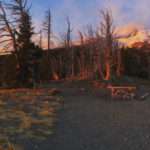By Steve Kruger, Executive Director, Trailkeepers of Oregon On October 27, trails professionals from nonprofits, outdoor recreation companies, and land management agencies came together in Bend, Oregon, for TKO’s first crack at hosting an Oregon Trails Summit. Trails…
By Michael McDowell, Newsletter Editor, Trailkeepers of Oregon
In the 1970s and 1980s, photographer Don Lowe and writer Roberta Lowe published the first trail guides for hiking in Oregon. Their series of hiking guidebooks opened trails throughout Oregon for a generation of hikers. On a rainy afternoon in November, Michael McDowell and John Sparks sat down with Roberta Lowe to discuss the outdoor career she and her husband Donald pursued. Responses have been edited for concision and clarity.
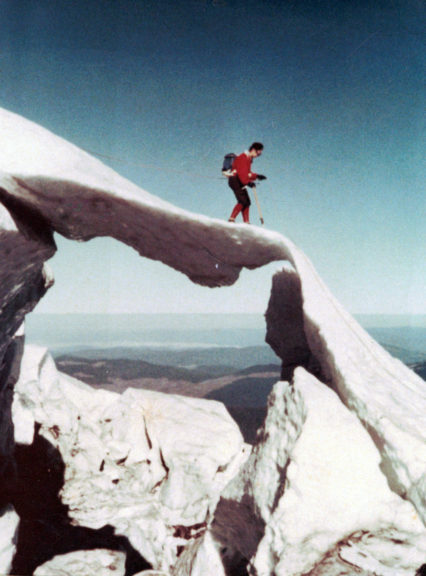
Roberta Lowe crosses a snow bridge on Mount St. Helens around 1964 while “wandering about until we had sufficiently amused ourselves.”
TKO: How did you get started writing trail guides?
The Mountaineers did a book of a hundred hiking trails in Washington [Louise B. Marshall, Bob Spring, and Ira Spring, 100 Hikes in Western Washington, 1966]. We belonged to the Mazamas then and Donald wrote a letter saying he would do the Oregon book because he was a photographer and would do the photographs for a certain percentage of the royalties. The president of the club then said something to the effect that he wouldn’t have anything to do with us. Donald said, well, we can do it. So we did it.
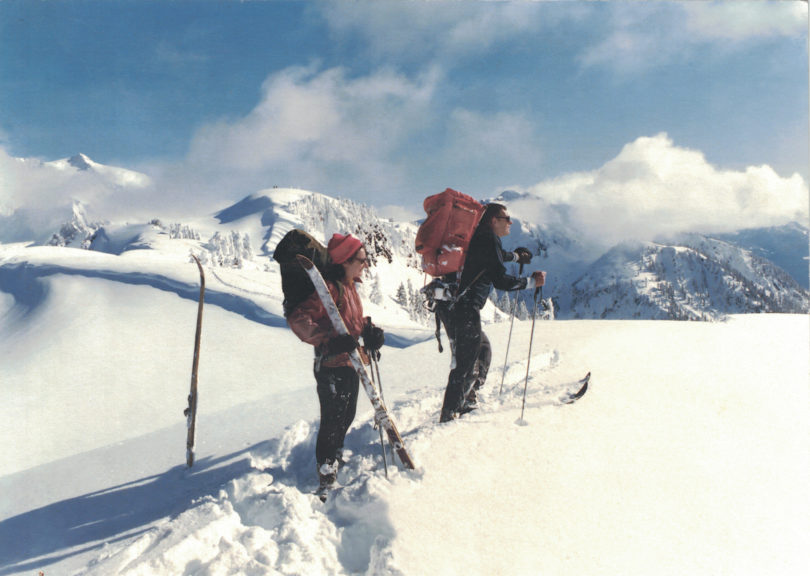
Roberta and Don Lowe skiing on Mt. Baker. Almost always their hiking and skiing were for a book or photo businesses.
We started working on the first book in 1967 and got it published in ’69. That was 100 Oregon Hiking Trails. A lot of the upper crust of the Mazamas were irritated about our book. One lady suggested that we should have donated all our royalties to the Mazamas, a thought that had never occurred to us. Then we did two books in California, because we were first kids on the block. There was only one hiking book in California then, and so we did one in Northern California and one in Southern California. Then we started dividing up the 100 Oregon Hiking Trails book into areas. Oral Bullard, the publisher of Touchstone Press, who published most of our books, was great at marketing. One of the fun books we did was 50 Hiking Trails: Portland & Northwest Oregon. We were doing a weekly hiking column for the [Oregon] Journal, doing different weird little hikes. It was the same old, same old. So we started to compile the hikes with extra ones and made that book.
TKO: You can’t do some of these hikes your books anymore. It’s good to go back to old hiking books and check out the hikes on trails that have since been abandoned, that nobody’s done for twenty years. Nowadays you get a hiking guide and it’s the hundred best hikes, the same trails that everyone does, and all those other trails are getting neglected. In TKO’s Oregon Hikers Field Guide we put in the normal trails, but we’re interested in including the abandoned ones and getting people back on them.
Yes. At some point, you think, oh, thank God these books are so old nobody’s going to have a hissy fit because of course everything changes. You can’t do the Bull Run or Warm Springs hikes anymore. When we did the Central Oregon book, it turned out the Black Butte Trail was relocated 180 degrees. When were working on one book [laughs] halfway through the book, I’m taking notes on the road numbers and I think, wait a minute, these road numbers are changing, they’re not the same. They were changing their road numbers in the middle of when we were doing the book. Fortunately we caught it and then just re-did them all. It was like anything—say a bike ride, and then they’re digging up the road and putting down gravel between when you scouted and when you write. You can’t believe everything you read.
TKO: What was your motivation to get started writing about trails?
A job. Then it was our only source of income. And it was fine. Donald worked for the med school when we started the books and I worked for an insurance company and I was finishing up college at the same time. We did the 100 Oregon Hiking Trails book in a summer and on the weekends. Don had a phenomenal ability to drive. One time we drove to the Wallowas and it was the first day of hunting season. That wasn’t too bright, was it? So we did just one hike and we turned around. Then we got a VW bus and we lived out of it as we were doing the books that we couldn’t do in a day. When we were doing the California books, we would hike—I don’t know how I did it—for a month, actually a day less than a month because I would rebuild on the last day. We were hiking twenty-five miles a day for almost a month. We were young. I think my favorite book was doing the John Muir Trail in the Sierra. People ask “What’s your favorite place to hike?” Well, that’s kind of hard. Who can say their favorite? Definitely the Sierra’s the favorite place to backpack. For Colorado we did the same thing. We take the VW bus, we go for a month, and then come home and reconnoiter. We were doing fine. It was kind of an informal thing with Oral. There would be periods of time when he would be giving us money, and then there would be times when the books were really selling well, and then we would be financing other things.
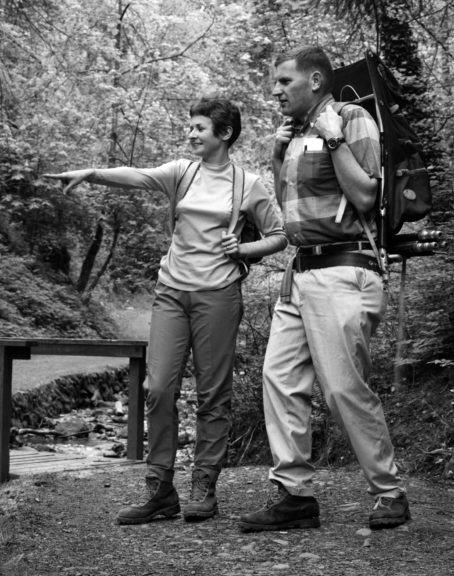
Roberta and Don pausing on a trail somewhere in the Portland area. The photo appeared on the back cover of 100 Northern California Hiking Trails, their second guide, published in 1970.
TKO: How did you divide the workload?
I always did everything except the actual photography and the printing and the maps. I did all the writing, I did all the paperwork. I did everything except the actual photo stuff, which was great because Don didn’t want to do the other stuff, and I couldn’t do his stuff, so it worked out fine.
After Oral died, Amato Publishing did a kind of picture-book hiking guide thingy in the Gorge with color photographs and that was it, the last one we did. By then we’d segued out of hiking books into scenic photography—we just hit the time right. It was just luck. The same thing with these books. It wasn’t because we were wonderful. We were just in the right place at the right time, and then ready to roll.
TKO: How did you choose the selections for your books?
Donald did all that. He went over maps and went over maps—and of course we’d been hiking a lot. We’d actually met through the Mazamas, and I’d done a lot of climbing and hiking on my own. I used to do backpacks by myself, overnight backpacks, and he’d done a lot. It was mostly research on his part.
TKO: There was no GPS in those days. How did you do mileage?
Donald did that, running it off on the maps. We tried to be consistent, like in Switzerland when they tell you the times. You learn right away, is it right how you do it, or is it faster or slower? So one of our goals was to be consistent. We’d say it’s going to take two and half hours, and you would say, “Oh yeah, sure, it’s going to take three,” or, “They’ve got to be kidding, it’s going to take two.” There was one trail, I think Ruckel Creek, I got a call from one of my friends who said, “Um, you said it was moderately steep on that trail. You might reconsider.”
And we got criticized by the Sierra Club. They said our books were worthless—because we weren’t pounding home environmental stuff. This is a time when people were just being harangued. We made a conscious decision. This is a hiking book. Aside from the introduction, where you say, you know, “Don’t pick the flowers, don’t litter,” it was a decision not to be environmentally yapping at people. That was not the point. It was a deliberate decision, not an oversight.
TKO: You also did mountain bike guide books.
We did a mountain biking book that didn’t sell at all. It was at the beginning. It was about the kind of mountain biking we did, on forest roads, not technical—we didn’t have that much technical then. That was one that didn’t sell. I wrote for the [Oregon] Journal, and Oregon magazine, and Willamette Week, and the Oregonian—outdoor stuff. We were doing cross-country skiing at the time, and we did some biking stuff.
Ask me if Forest Park should open the trails to biking, on trails that are already there: Absolutely, positively no. No exceptions. I think they should be able to find a place in Forest Park where they could develop trails. There should be specially built trails for them. But no way on any of the existing trails. This comes from cyclists, too. If nothing else, just the psychological effect of wondering if—these people aren’t putzing along at three miles an hour. They want to go as fast as they can. It’s not that I’m saying they shouldn’t have trails. That’s not it at all. Just not on the established routes.
Two years ago, we hiked up the road to the top of the Sandy Ridge Trail System. There were mountain bikers biking up beside us. We got to the trailhead and they said something real nice, I don’t remember what. I said, “We’re not hiking on your trails. Those are your trails.” I think there are trails where hikers shouldn’t be permitted. Those guys, if they want to race down those trails that are built for them, they don’t want some idiot hikers there. Those are their trails. It’s kind of sad across Lyle, at Coyote Wall. They built these trails for the bikers and then the hikers take over.
TKO: You and Don lived in Sandy, Oregon, very close to Mount Hood, for forty-nine years.
We did a big picture book on Mount Hood, a coffee table book, in ’75 [Mount Hood: Portrait of a Magnificent Mountain]. That was fun. All our windows on the east side of the house looked at Hood, so we’d get up and say, “Oh, the weather is good.” And we’d pop up there and do stuff. I can’t tell you the number of times were going to be doing photography at Rainier. We would get as far as Gresham, and look and turn around. In the woods you want clouds, nice thin clouds. If you’re outdoors, you want blue sky, for scenic photography. Real straight forward stuff.
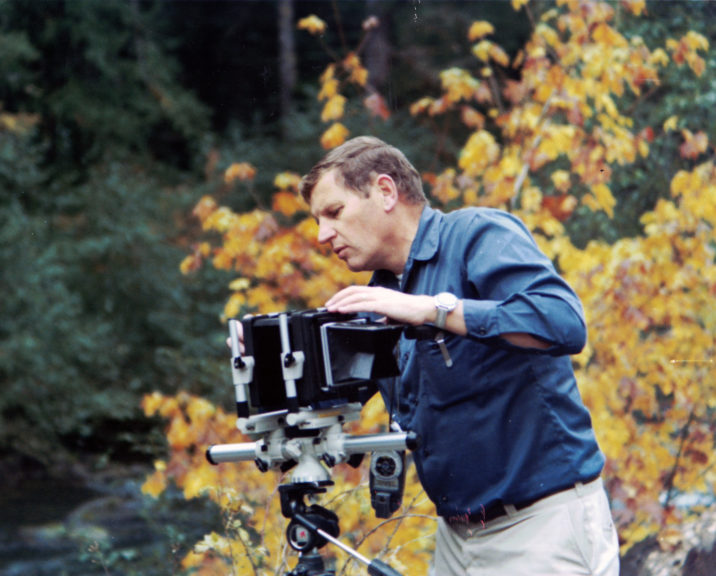
Don Lowe adjusts his camera. “Much of Don’s scenic photography was in large format—4 x 5, 5 x 7, and 8 x 10,” Roberta notes.
TKO: You’ve always been involved with the outdoors?
I did my backpacks when I was in my early twenties. My dad would drop me off at one place, and pick me up at the other. The trails weren’t opened yet. The Ruckel Creek Trail wasn’t through, the Herman Creek Trail—at the top—was there, but it was very—let’s put it this way: I wasn’t lost, I knew where I was, I just wasn’t where I wanted to be. When I did Ruckel Ridge, I had to camp on top. I finally got to Chinidere. I had run out of water, but I obviously made it. I was coming down Herman Creek and I was aware, right near the top, that there weren’t cobwebs across the trail. And I looked ahead and here was this bear, ambling down the trail, big, black—actually he was small—and I was thinking, “I’m meeting my dad at the bottom of Herman Creek. No way Jose am I going back the other way.” I just walked real slowly, and pretty soon there were cobwebs. Ah! The bear had gone off the trail. Later on that day I was walking near the bottom and I heard a sound. I knew it wasn’t a deer. And I looked over the edge of the trail and here was this fluffy light-brown bear, moseying up the slope. A bear walking away, a bear coming towards you, the feeling is not the same.
I’d never been into a kayak until this summer. It was fun. I am such a blackwater girl. No slough is too good for me. We did a trip on the Willamette, this lady and I. That was fun because there was so much going on. And then we did the bay at Scappoose, which was a little too bucolic for me. But there was a bunch of river otters that came out and did a show for us. That was as close as I am to you. Doing a little who-ha. That was cool.
I was in my early twenties in the snow bridge photo on Mt. St. Helens. I was with a bunch of good climbers, and we just wandered all over St. Helens. There was a snow bridge, about this thick, and there I am crossing it. We think it collapsed later in the day.
Don and Roberta Lowe Trail Guides
1969 – 100 Oregon Hiking Trails, Touchstone Press
1970 – 100 Northern California Hiking Trails, Criterion-Touchstone Press
1972 – 100 Southern California Hiking Trails, Touchstone Press
1973 – 80 Northern Colorado Hiking Trails, Touchstone Press
1974 – 70 Hiking Trails: Northern Oregon Cascades, Touchstone Press
1975 – Mount Hood: Portrait of a Magnificent Mountain, Caxton Printers
1976 – 50 West Central Colorado Hiking Trails, Touchstone Press
1978 – 60 Hiking Trails: Central Oregon Cascades, Touchstone Press
1979 – 62 Hiking Trails: Northern Oregon Cascades, Touchstone Press
1980 – 35 Hiking Trails: Columbia River Gorge, Touchstone Press
1981 – 41 Hiking Trails: Northwestern California, Touchstone Press
1982 – The John Muir Trail: A Complete Hiking Guide, Caxton Press
1985 – 33 Hiking Trails: Southern Washington Cascades, Touchstone Press
1986 – 50 Hiking Trails: Portland & Northwest Oregon, Touchstone Press
1987 – 50 Hiking Trails: Lassen, Tahoe, Carson Pass, Touchstone Press
1990 – 34 Mountain Bike Routes: Northern Oregon Cascades, Touchstone Press
2000 – Columbia Gorge Hikes: 42 Scenic Hikes, Frank Amato Publications

